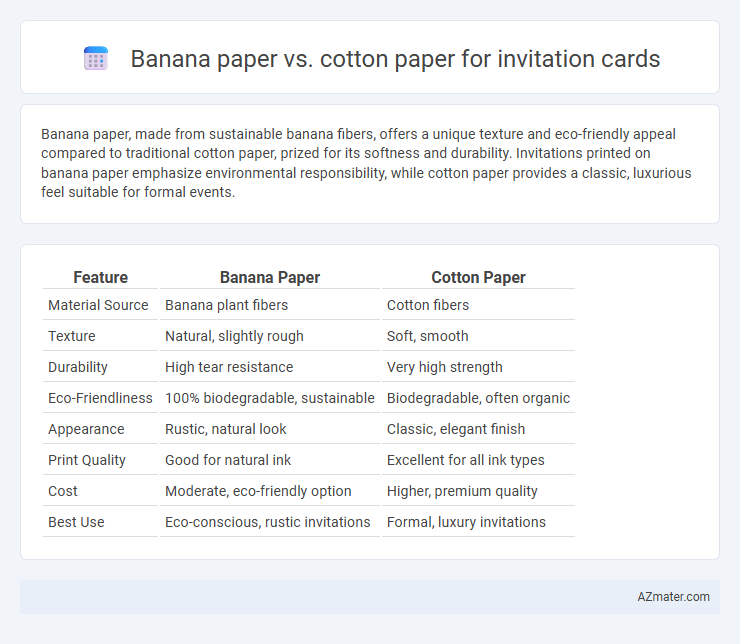Banana paper, made from sustainable banana fibers, offers a unique texture and eco-friendly appeal compared to traditional cotton paper, prized for its softness and durability. Invitations printed on banana paper emphasize environmental responsibility, while cotton paper provides a classic, luxurious feel suitable for formal events.
Table of Comparison
| Feature | Banana Paper | Cotton Paper |
|---|---|---|
| Material Source | Banana plant fibers | Cotton fibers |
| Texture | Natural, slightly rough | Soft, smooth |
| Durability | High tear resistance | Very high strength |
| Eco-Friendliness | 100% biodegradable, sustainable | Biodegradable, often organic |
| Appearance | Rustic, natural look | Classic, elegant finish |
| Print Quality | Good for natural ink | Excellent for all ink types |
| Cost | Moderate, eco-friendly option | Higher, premium quality |
| Best Use | Eco-conscious, rustic invitations | Formal, luxury invitations |
Introduction to Banana Paper and Cotton Paper
Banana paper, made from banana plant fibers, offers an eco-friendly and sustainable alternative to traditional paper, featuring a textured, natural finish ideal for unique invitation cards. Cotton paper, composed primarily of cotton linters, is renowned for its durability, smooth surface, and archival quality, making it a popular choice for formal invitations. Both materials differ significantly in environmental impact, texture, and longevity, influencing the overall aesthetic and sustainability of invitation cards.
Origins and Production Processes
Banana paper originates from the fiber of banana plants, primarily sourced from agricultural waste in tropical regions, and involves a mechanical pulping process that is environmentally friendly and sustainable. Cotton paper is derived from cotton linters or rags, utilizing a more traditional, labor-intensive manufacturing process that produces a durable and high-quality material favored for fine stationery. Both papers offer distinct textures and ecological footprints, with banana paper emphasizing renewable waste use and cotton paper highlighting long-lasting fiber strength.
Environmental Impact and Sustainability
Banana paper, made from banana plant fibers, offers a sustainable alternative to cotton paper by utilizing agricultural waste and reducing reliance on water-intensive crops. It significantly lowers environmental impact through biodegradability and a smaller carbon footprint compared to traditional cotton paper, which requires substantial water and pesticides for cultivation. Choosing banana paper for invitation cards supports eco-friendly practices by promoting renewable resource use and minimizing waste in the paper production process.
Texture and Aesthetic Appeal
Banana paper offers a unique, fibrous texture with natural variations that enhance the rustic and eco-friendly aesthetic of invitation cards, making each piece distinctly organic and tactile. Cotton paper delivers a smooth, luxurious feel known for its durability and high-end appearance, providing a classic and refined look that holds ink exceptionally well. Both materials elevate invitation cards through their distinct textures, with banana paper appealing to environmentally conscious design while cotton paper supports a timeless elegance.
Printability and Color Reproduction
Banana paper offers a textured surface that absorbs ink well, resulting in vibrant color reproduction, but its fibrous nature can slightly blur fine details compared to the smoother finish of cotton paper. Cotton paper, known for its ultra-smooth texture and high-quality fibers, ensures crisp printability and sharp color contrasts, making it ideal for intricate designs and detailed invitation cards. For invitations requiring precise color accuracy and elegant print clarity, cotton paper outperforms banana paper in delivering superior print fidelity and durability.
Durability and Longevity
Banana paper offers significant durability due to its fibrous strength and natural resistance to tearing, making invitation cards last longer under various environmental conditions. Cotton paper is renowned for its exceptional longevity and archival quality, often preserving invitations for decades without yellowing or degrading. While banana paper provides eco-friendly toughness, cotton paper ensures a premium, long-lasting finish ideal for keepsake invitations.
Cost Comparison for Invitation Cards
Banana paper is typically more cost-effective than cotton paper for invitation cards, with prices averaging around $0.30 to $0.50 per sheet compared to cotton paper's $1.00 to $1.50 per sheet. The biodegradable nature of banana fibers reduces processing costs, making banana paper a budget-friendly option without compromising quality. Bulk orders of banana paper invitations further decrease overall expenses, making it an economical choice for environmentally conscious events.
Customization Options and Finishing Techniques
Banana paper offers unique customization options such as natural fiber patterns and eco-friendly dyes, making each invitation card distinct with a rustic, organic look. Cotton paper provides a smooth, luxurious surface ideal for fine detail printing and supports diverse finishing techniques like embossing, foil stamping, and letterpress with exceptional clarity. Both materials allow for vibrant color reproduction, but cotton paper excels in durability and the refinement of intricate finishes for premium invitation cards.
Consumer Preferences and Trends
Banana paper for invitation cards is gaining popularity among eco-conscious consumers who prioritize sustainability and unique texture, often associating it with environmental responsibility. Cotton paper remains favored for its luxurious feel, durability, and traditional elegance, appealing to those valuing a classic and premium invitation experience. Current trends indicate a growing demand for biodegradable materials like banana paper, driven by millennial and Gen Z consumers, while cotton paper retains strong preference in formal and high-end events.
Choosing the Right Paper for Invitations
Banana paper offers a sustainable and eco-friendly option for invitation cards, featuring unique textures and natural fibers that enhance tactile appeal while supporting environmental conservation. Cotton paper remains a premium choice known for its durability, luxurious softness, and ability to hold ink vibrantly, making it ideal for elegant and formal invitations. Selecting the right paper depends on balancing desired aesthetic qualities, budget considerations, and environmental impact, with banana paper suited for rustic or eco-themed events and cotton paper preferred for high-end, timeless invitations.

Infographic: Banana paper vs Cotton paper for Invitation card
 azmater.com
azmater.com